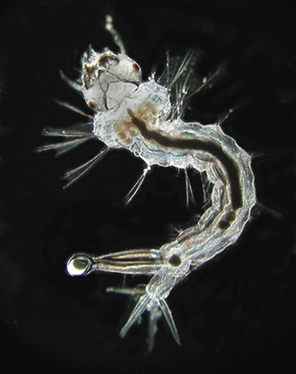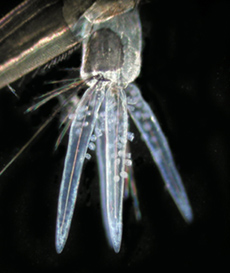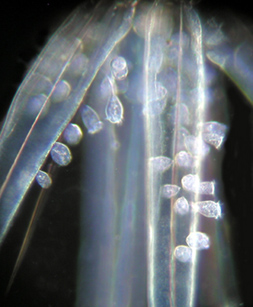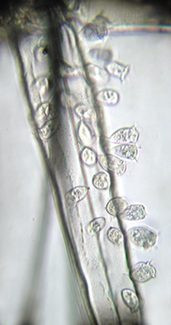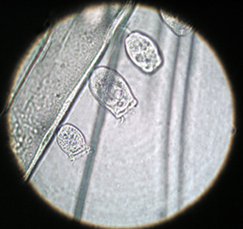Epizoics on a mosquito larvaMichael Reese Much Bethlehem, Pennsylvania, USA Click each image to view a larger version
|
||
|
|
||
|
One of the more fascinating subjects for the microscopists are mosquito larvae—commonly
known as “wrigglers.” These fairly large specimens—8 to 10 millimeters in length—barely fit into the field of view
of a 4X objective. The image to the left is at 40X. At it’s tail end the wriggler has a breathing tube (there is
a bubble on the tip of this specimen's tube) and around its anus a cluster of feather-like fins. |
||
|
|
||
|
The
epizoics appear not to harm the larva but seem to feed on minute particles passing through the wrigglers gut—and
a wriggler is almost all gut. The dark mass running through its body is fecal matter. I attempted to get “cleaner”
specimens by progressive changes of water, but the larvae are very efficient feeders. |
||
|
|
||
|
If you see how severe the thrashing motion of a swimming wriggler
is you can appreciate how firmly the epizoics are able to grip the fins of the wriggler. The view to the left is
at 400X. |
||
|
|
||
|
A few comments about specimen preparation: |
||
|
|
||
|
I’ve been buying stuff from a retired pathologist and got several thousand of these 24X40 slips for $20. I got a Spencer microtome for $50. If anyone needs an automatic slide processor(dehydrating, staining) he’s got one for $100. I am shooting with an Olympus C-4040 digital camera on an Omano trinocular microscope modified with a Wild achromatic aplanatic variable phase condenser. I am in the process of upgrading my objectives. If anyone knows of any objectives with iris diaphragms in them that are available I would appreciate the lead. 1000X oil immersion. |
||
|
|
All comments to the author Michael Much are welcomed. Acknowledgement: Thank you to the readers who provided feedback on an earlier version of this article and who provided help on the identification of the epizoics. |
|
|
|
||
